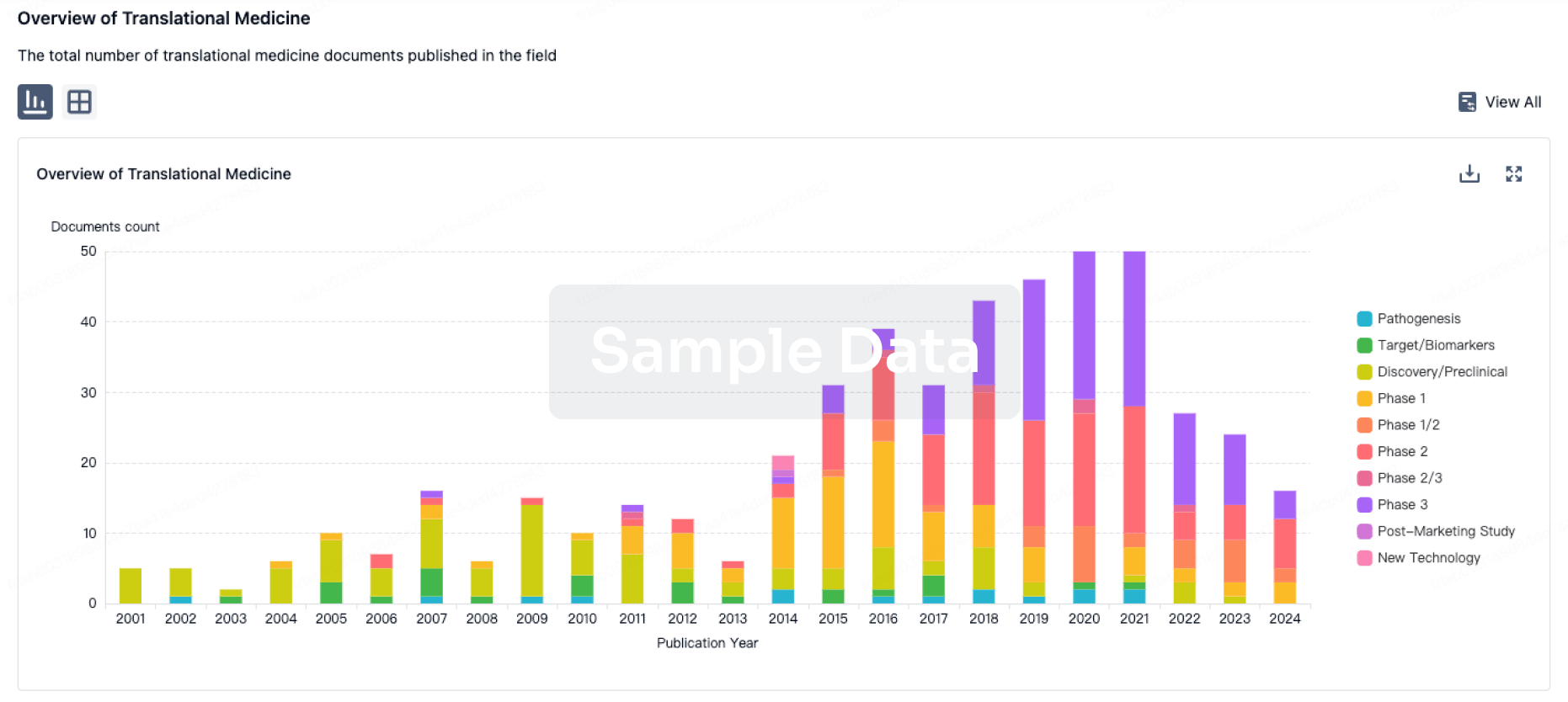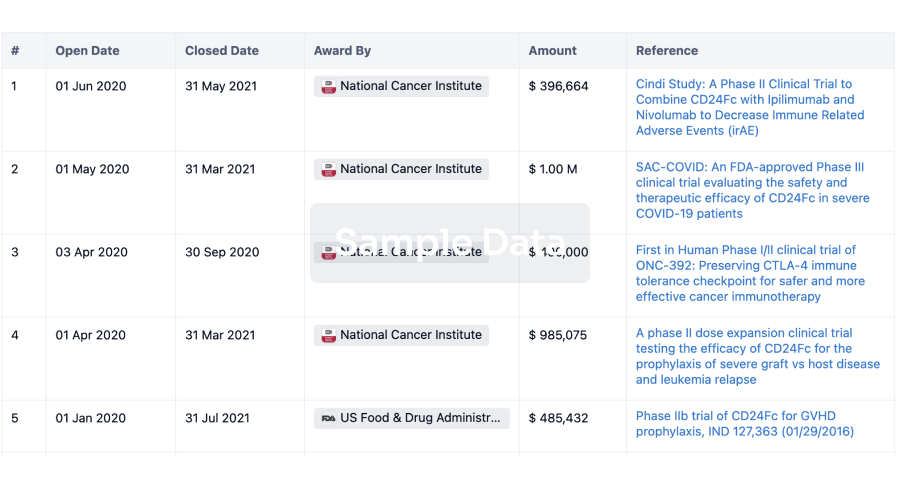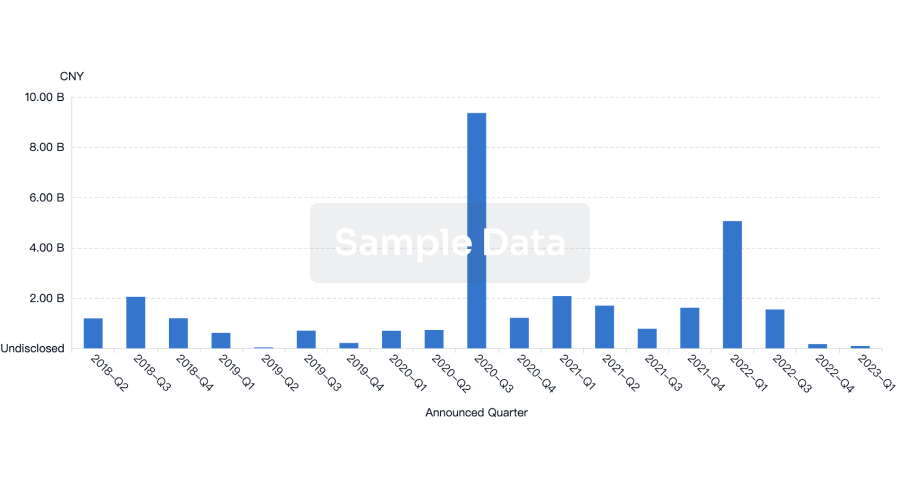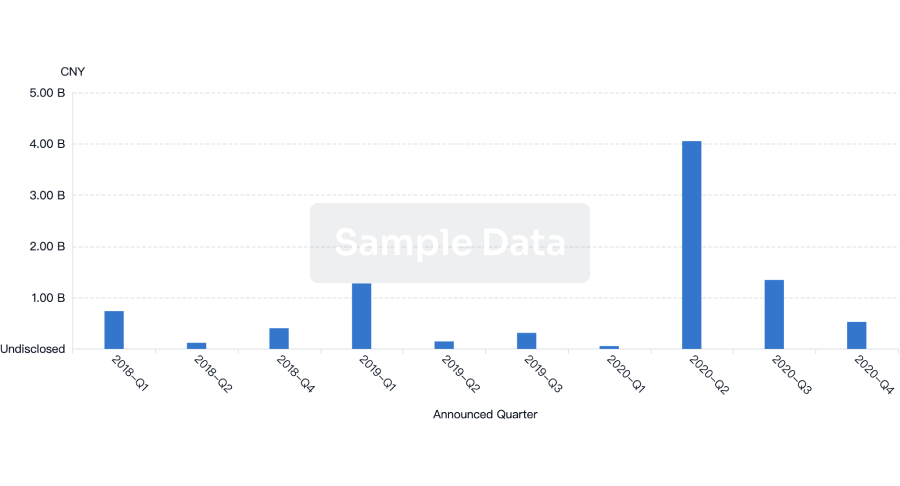Request Demo
Last update 08 May 2025

Institute for Medical Research, Inc.
Last update 08 May 2025
Overview
Tags
Congenital Disorders
Immune System Diseases
Respiratory Diseases
Small molecule drug
Disease domain score
A glimpse into the focused therapeutic areas
No Data
Technology Platform
Most used technologies in drug development
No Data
Targets
Most frequently developed targets
No Data
| Disease Domain | Count |
|---|---|
| Neoplasms | 1 |
| Immune System Diseases | 1 |
| Top 5 Drug Type | Count |
|---|---|
| Small molecule drug | 1 |
| Top 5 Target | Count |
|---|---|
| TGF-β(Transforming growth factor beta) | 1 |
Related
1
Drugs associated with Institute for Medical Research, Inc.Target |
Mechanism TGF-β inhibitors |
Active Org. |
Originator Org. |
Drug Highest PhaseApproved |
First Approval Ctry. / Loc. Japan |
First Approval Date15 Jun 1982 |
5
Clinical Trials associated with Institute for Medical Research, Inc.NCT05570812
In Vivo Targeting of Neuroactive Steroid and Immune Networks for Depression in People Living With HIV
This study will determine the effects of pregnenolone on brain function, inflammation and depressive symptoms in people with HIV who have depression. Participants in this study will receive a pill of either pregnenolone or placebo, and can stay on their current antidepression medications. Brain imaging and behavioral assessments will be performed during the study.
Start Date03 Mar 2023 |
Sponsor / Collaborator |
NCT04793698
Multisite Feasibility of Compassion Meditation for Veterans With Posttraumatic Stress Disorder (PTSD)
Compassion meditation (CM) is a contemplative practice that builds compassion for and connectedness with others. CM has shown promise as a way of enhancing recovery for Veterans with Posttraumatic Stress Disorder (PTSD). The proposed project will examine the feasibility of a clinical trial by assessing our ability to deliver CM and a control intervention consistently with a diverse groups of Veterans from different parts of the country and optimizing the way in which outcomes are determined.
Start Date06 May 2021 |
Sponsor / Collaborator  Emory University Emory University [+3] |
ISRCTN81915073
Effectiveness of novel tools for integrated vector control management on the incidence of dengue in Malaysia: a cluster randomized controlled trial
Start Date10 Feb 2020 |
Sponsor / Collaborator |
100 Clinical Results associated with Institute for Medical Research, Inc.
Login to view more data
0 Patents (Medical) associated with Institute for Medical Research, Inc.
Login to view more data
46
Literatures (Medical) associated with Institute for Medical Research, Inc.01 Mar 2025·Journal of Endourology
Focal Therapy: The Art of Harmonizing Cancer Control with Quality of Life
Author: Sanchez-Salas, Rafael ; Polascik, Thomas J. ; Mottaghi, Mahdi
01 Feb 2025·Breast Cancer Research and Treatment
Concordant and discordant breast density patterns by different approaches for assessing breast density and breast cancer risk
Article
Author: Kim, Minjeong ; Kim, Tae Soo ; Kim, Ki Hwan ; Kwon, Mi-Ri ; Kwon, Ria ; Ryu, Seungho ; Kim, Eun Young ; Choi, JunHyeok ; Jeong, Han Eol ; Lim, Ga-Young ; Park, Eun Kyung ; Lee, Sanghyup ; Cho, Yoosun ; Lee, Hyeonsoo ; Kook, Shin Ho ; Park, Boyoung ; Chang, Yoosoo
01 Jan 2025·Journal of Affective Disorders
Menopausal stage transitions and their associations with overall and individual sleep quality in middle-aged Korean women
Article
Author: Guallar, Eliseo ; Kim, Chanmin ; Hong, Yun Soo ; Cho, Juhee ; Park, Jihwan ; Park, Junhee ; Kim, Kye-Hyun ; Park, Hyun-Young ; Zhao, Di ; Lim, Ga-Young ; Chang, Yoosoo ; Jang, Yoonyoung ; Jeon, Sang Won ; Kang, Jeonggyu ; Ryu, Seungho ; Kwon, Ria ; Kim, Hoon
7
News (Medical) associated with Institute for Medical Research, Inc.11 Feb 2025
Walter and Eliza Hall Institute of Medical Research in Victoria, Australia led one of the largest eye studies in the world that used AI to analyse eye images of over 50,000 people to better understand the retina's connection with various diseases.
The international study, funded by California-based Lowy Medical Research Institute, tapped into a dataset of optical coherence tomography (OCT) images from around 54,000 individuals stored at the UK Biobank. Utilising a convolutional neural network, it generated "the highest-resolution spatial dataset of retinal thickness ever produced," creating 50,000 maps with measurements at over 29,000 locations across the retina.
Moorfields Eye Hospital and University College London from the United Kingdom and the University of Washington in the United States were collaborators in the study.
FINDINGS
While previous studies have indicated correlations between retinal thickness and diseases, the WEHI-led research provided a deeper look into the complex anatomy of the retina.
One of the significant findings of this study, published in Nature Communications, is that reduced retinal thickness is "highly associated" with multiple sclerosis (MS), a chronic neurological disease affecting the brain and spine. "This result provides strong, independent confirmation of multiple reports of the utility of OCT as the source of biomarkers for MS and MS progression," it added.
Retinal thinning is also highly associated with a range of other neurodegenerative diseases, as well as cardio-metabolic disorders.
"We illustrated that the retina has unique metabolic sensitivities, with retinal thickness associated with multiple systemic metabolic diseases, and metabolites previously implicated in several retinal diseases," the study explained.
Additionally, the study identified genetic factors that influence retinal thickness, suggesting that at least 294 genes play a role in the retina's growth and development.
WHY IT MATTERS
Researchers claim their study opens up the potential for using routine eye imaging to screen for and manage diseases. Neurodegenerative conditions like dementia and metabolic disorders such as diabetes are linked to degeneration or disruption of the central nervous system, which the retina is a part of.
"We’ve shown that retinal imaging can act as a window to the brain, by detecting associations with neurological disorders like multiple sclerosis and many other conditions," lead researcher Dr Vicki Jackson from WEHI.
The study specifically points to the potential for retinal thickness as a diagnostic biomarker "to aid in detecting and tracking the progression of numerous diseases."
"We can now pinpoint specific locations of the retina which show key changes in some diseases," Dr Jackson said.
Moreover, the study contributes to the growing field of oculomics as a "non-invasive approach for predicting and diagnosing diseases."
THE LARGER TREND
Another Australian study has linked the damage to the conjunctiva of the eye to pterygium, or tissue growth on the cornea, which can be an early predictor of skin cancer. A desktop and mobile AI-driven detection system has been developed to assess sun-related eye damage.
The Singapore Eye Research Institute has also utilised AI to scan people's retinal photos and assess their health conditions. Over the past five years, it developed two novel solutions: one for screening chronic kidney disease and another for predicting a person's biological age.
Meanwhile, in China, a generative AI model was built for automated eye disease diagnosis. Called VisionFM, it was pre-trained using 3.4 million eye images from over 500,000 people worldwide. Besides diagnosing eye diseases, it can be applied to eye disease progression prediction, systemic biomarker prediction through ocular imaging, intracranial tumour prediction, and lesion, vessel, and layer segmentation.
09 Aug 2023
Ramsay Health Care, one of Australia's largest private healthcare providers, is partnering with Google Cloud to acquire the capability to harmonise and harness data across its network to improve clinical and operational outcomes.
Ramsay told
Healthcare IT News
that it chose Google Cloud as its data and innovation partner in fulfilling its 2030 digital transformation strategy.
A key component of this strategy is the creation of a centralised data hub, which will be built using Google Cloud's enterprise data warehouse, BigQuery.
The data hub, to be delivered in partnership with Google Cloud consultant Kasna, will allow Ramsay to safely ingest, store, and analyse both real-time data and diverse swaths of raw data. Patient data will be encrypted end-to-end through Google Cloud's infrastructure and data storage.
Google Cloud will also be deploying the Apigee API Management and Anthos Service Mesh solutions to support data interoperability.
WHY IT MATTERS
Ramsay operates a network of more than 70 hospitals, clinics, and surgical centres across Australia. With healthcare service demand expected to rise gradually each year, the amount of data they hold is also projected to increase.
However, its patient and administrative data are held in separate on-premise locations, "making analysis and insights extraction a time-intensive and cumbersome process," according to Dr Rachna Gandhi, chief digital and data officer of Ramsay Health Care.
For this reason, Ramsay is building a centralised data hub, powered by Google Cloud, that will provide a single source of truth for all its data. This will allow the group to operationalise data, improve connectivity, and unlock new insights to support clinical decision-making.
Aside from having better access to data and "significantly" improving data management, its partnership with Google Cloud will allow the organisation to use AI and ML tools, which have a "crucial role" in streamlining operational and clinical workflows, Dr Gandhi said.
"For example, AI can reduce the administrative burden on clinicians and nurses, releasing further capacity to care for patients. AI will help doctors identify patients at risk of illness and our clinicians will also be able to use AI-powered tools to extract insights and enhance clinical decision-making by identifying patterns and trends that may not be obvious," she explained further.
Ramsay Health Care is also looking to use AI to optimise clinical coding to improve accuracy, reducing the burden on medical coders.
It will also explore the use of AI in forecasting demand to ensure medications will not go to waste and to enable a more systematic allocation of procedures for optimising theatre and staff utilisation.
With Google Cloud, Ramsay is scaling its adoption of AI "without the need for purchasing additional hardware and devoting manpower towards building new systems."
THE LARGER TREND
Google Cloud has been actively supporting the digital transformations of health systems around Asia-Pacific. Early this year, it started working with
Synapxe
- formerly the Integrated Health Information Systems, in Singapore to scale the access to API gateway for developers to create new applications and capabilities for the healthcare system.
Through Amwell, Google Cloud has recently powered the virtual and remote care capabilities of
Manipal Hospitals
in India. The healthcare group is also adopting its conversational AI tools to enhance patient interactions.
Google Cloud has also helped process
about 14,000 genomes – touted as the
largest genome data set in Australia to date – with the
Garvan
Institute of Medical Research in Sydney to drive the early diagnosis of rare genetic disorders.
Meanwhile, Ramsay is trying out this month a cloud-based platform that will provide patients and specialists with a single entry into its digital ecosystem. It will feature a pre-admission dashboard, digital consent capabilities, and payment systems.
ON THE RECORD
"We are on a significant journey to transform into a digitally enabled, data-informed integrated healthcare provider. As part of this transformation, we are excited to work with Google Cloud to unlock the maximum potential of data and AI and revolutionise the healthcare industry. We are committed to offering gold-standard clinical care while maintaining a responsible approach to data governance and privacy, and ensuring our customers retain control over their data," Dr Gandhi said about their partnership with Google Cloud.
05 Dec 2022
LONDON--(BUSINESS WIRE)-- Ellipses Pharma Limited (“Ellipses”), a global drug development company focused on accelerating the development of new oncology treatments, will present a “Trial in Progress” poster detailing the design of a Phase 1/2 trial of vosilasarm (EP0062) in advanced breast cancer at the San Antonio Breast Cancer Symposium (SABCS) in San Antonio, Texas on Tuesday, 6 December from 5:00pm to 6:15pm CST.
Vosilasarm is a selective androgen receptor modulator (SARM) under development for the potential treatment of advanced breast cancer. This study is designed to further extend the evaluation of vosilasarm as a potential therapy for AR+/HER2–/ER+ advanced breast cancer, with the primary aim of identifying a recommended phase 2 dose (RP2D). Recruitment has commenced and the study will recruit up to 130 patients globally.
Presentation details
Title
A phase 1/2 study to evaluate the safety and efficacy of EP0062, an oral Selective Androgen Receptor Modulator (SARM), for the treatment of AR+/HER2-/ER+ advanced breast cancer
Presenter
Professor Elgene Lim, Institute of Medical Research, University of New South Wales, Sydney, Australia;
Abstract number
OT1-02-02
Date and time
Tuesday December 6, 2022; 5:00 PM - 6:15 PM
Session name
Trial in Progress Session
Location
Henry B. González Convention, San Antonio, Texas
Professor Hendrik-Tobias Arkenau, Global Head of Drug Development and Chief Medical Officer at Ellipses, said:
“Developing promising assets at speed is fundamental to the work of Ellipses, and we are excited to be presenting this ongoing study at such an important scientific conference. We look forward to presenting further details on this trial, including results, in the future.”
Dr Rajan Jethwa, CEO of Ellipses, said:
“The initiation of this trial for vosilasarm is another key milestone towards our goal of accelerating the development of promising cancer drugs. I am excited by the potential across our pipeline to make available much-needed drugs for patients with cancer.”
About vosilasarm / EP0062
Vosilasarm is an oral, non-steroidal, SARM currently being developed for the treatment of AR+/HER2-/ER+ advanced breast cancer. The efficacy and safety of vosilasarm has previously been investigated in a small Phase 1 clinical trial of AR+/HER2–/ER+ advanced breast cancer, and was demonstrated to have acceptable tolerability with preliminary evidence of clinical efficacy (LoRusso et al. Clinical Breast Cancer 2022 22;1 67-77).
About AR+/HER2–/ER+ advanced breast cancer
Despite recent progress, advanced ER+/HER2- breast cancer remains an area of high unmet medical need. It is estimated that 75-90% of advanced ER+ breast cancers are androgen receptor (AR) positive. It has been established that the AR acts as a tumour suppressor in multiple contexts of ER+ breast cancer, including where resistance to current endocrine-based regimens develops (Hickey et al. Nature Medicine 2021 27; 310-320). This provides the rationale for evaluating vosilasarm, an AR agonist, as a potential treatment strategy.
About Ellipses Pharma Limited
Ellipses Pharma is a global drug development company based in London, focused on accelerating the development of cancer medicines and treatments through an innovative drug development model that combines unbiased vetting to de-risk initial asset selection with an uninterrupted funding flow to minimize the time it takes to advance lead products through clinical trials and reach patients.
For more information, please visit ellipses.life
View source version on businesswire.com:
Contacts
Ellipses Pharma Ltd
Suzanne Wood
media@ellipses.life
Source: Ellipses Pharma Limited
View this news release online at:
Phase 1
100 Deals associated with Institute for Medical Research, Inc.
Login to view more data
100 Translational Medicine associated with Institute for Medical Research, Inc.
Login to view more data
Corporation Tree
Boost your research with our corporation tree data.
login
or

Pipeline
Pipeline Snapshot as of 23 Dec 2025
The statistics for drugs in the Pipeline is the current organization and its subsidiaries are counted as organizations,Early Phase 1 is incorporated into Phase 1, Phase 1/2 is incorporated into phase 2, and phase 2/3 is incorporated into phase 3
Preclinical
1
Login to view more data
Current Projects
| Drug(Targets) | Indications | Global Highest Phase |
|---|---|---|
Tranilast ( TGF-β ) | Pulmonary Fibrosis More | Preclinical |
Login to view more data
Deal
Boost your decision using our deal data.
login
or

Translational Medicine
Boost your research with our translational medicine data.
login
or

Profit
Explore the financial positions of over 360K organizations with Synapse.
login
or

Grant & Funding(NIH)
Access more than 2 million grant and funding information to elevate your research journey.
login
or

Investment
Gain insights on the latest company investments from start-ups to established corporations.
login
or

Financing
Unearth financing trends to validate and advance investment opportunities.
login
or

AI Agents Built for Biopharma Breakthroughs
Accelerate discovery. Empower decisions. Transform outcomes.
Get started for free today!
Accelerate Strategic R&D decision making with Synapse, PatSnap’s AI-powered Connected Innovation Intelligence Platform Built for Life Sciences Professionals.
Start your data trial now!
Synapse data is also accessible to external entities via APIs or data packages. Empower better decisions with the latest in pharmaceutical intelligence.
Bio
Bio Sequences Search & Analysis
Sign up for free
Chemical
Chemical Structures Search & Analysis
Sign up for free

